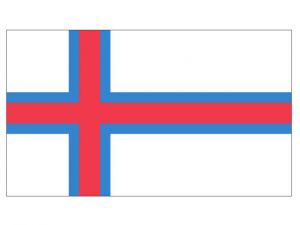Language/Faroese/Vocabulary/Eating-and-Drinking
| ◀️ Common Foods — Previous Lesson | Next Lesson — Possessive Adjectives ▶️ |
Faroese is a North Germanic language spoken on the Faroe Islands. It has a relatively small vocabulary compared to other languages, but it has its own unique set of words and phrases for various domains. In this article, we will delve into the vocabulary related to eating and drinking in Faroese.
Faroese Vocabulary for Eating and Drinking[edit | edit source]
- Matur - Food
- Drykkur - Drink
- Spísa - To eat
- Drekka - To drink
- Kjøt - Meat
- Fiskur - Fish
- Grønmeti - Vegetables
- Korn - Grains
- Breyð - Bread
- Kaffi - Coffee
- Te - Tea
- Vatn - Water
- Mjólk - Milk
- Ávís - Juice
- Bjór - Beer
- Vín - Wine
- Brennivín - Schnapps
- Egg - Egg
- Jurtaolía - Vegetable oil
- Hnetur - Nuts
- Ostur - Cheese
- Sykur - Sugar
- Salt - Salt
- Pipar - Pepper
- Sósa - Sauce
- Kartöflur - Potatoes
- Kex - Biscuits
- Hangikjöt - Smoked lamb
- Grautur - Porridge
- Ávaxtir - Fruit
- Súkkulaði - Chocolate
- Ferskt - Fresh
- Saður - Yogurt
- Hveiti - Wheat
- Ól - Ale
- Límonaði - Lemonade
- Máltingur - Malt
Dialogue[edit | edit source]
- Let's use the vocabulary we have just learned in context with the following dialogue:
- Anna: Hey, hvað viltu borða? (Hello, what do you want to eat?)
- Jón: Ég vil borða fisk, takk. (I want to eat fish, please.)
- Anna: Vel, ég ákvað að gera saltfisk, er það í lagi? (Alright, I decided to make salted fish, is that okay?)
- Jón: Já, það hljómar gott. En ég þarf að fá líka brauð til að borða með. (Yes, that sounds good. But I also need to get bread to eat with.)
- Anna: Ég er búin að baka rúgbrauð, það er heima í skápnum. (I already baked rye bread, it's in the cupboard.)
- Jón: Takk, það hljómar vel. Og hvað varðar drykk, hvað er að velja? (Thank you, that sounds good. And as for drinks, what's available?)
- Anna: Ég hef vatn, ávís, og bjór í kælinu. Hvað viltu drekka? (I have water, juice, and beer in the fridge. What do you want to drink?)
- Jón: Ég tek bjór, takk fyrir. (I'll take beer, thank you.)
Quiz[edit | edit source]
Now, let's evaluate your knowledge with this quiz:
- What is the Faroese word for "food"? a. Matur b. Drykkur c. Spísa d. Drekka
- What is a common meat in Faroese cuisine? a. Beef b. Chicken c. Pork d. Lamb
- What is the Faroese word for "bread"? a. Korn b. Breyð c. Kaffi d. Te
- What is the traditional Faroese bread made from? a. Wheat flour b. Cornmeal c. Rye flour d. Barley flour
- What is considered impolite during Faroese meals? a. Using utensils b. Drinking alcohol c. Beginning to eat before everyone is seated d. Talking with your mouth full
Answers:[edit | edit source]
- a. Matur
- d. Lamb
- b. Breyð
- c. Rye flour
- c. Beginning to eat before everyone is seated
Faroese Cuisine[edit | edit source]
Faroese cuisine has a strong emphasis on seafood due to the islands' location in the North Atlantic Ocean. The most common fish dishes include salmon, cod, and haddock. Other popular dishes include lamb, pork, and poultry. Faroese cuisine also features a variety of dairy products, such as skyr (a type of yogurt) and ræstur fiskur (fermented fish). Traditional Faroese bread is made from rye flour and is often served with butter and cheese.
Faroese Table Manners Faroese table manners are similar to those in other Nordic countries. It is considered impolite to begin eating before everyone is seated and ready to eat. It is also common to wait until the host says "vælkomin" (welcome) before starting to eat. It is customary to use utensils, including a fork and knife, when eating. Drinking alcohol during meals is not uncommon, but excessive drinking is frowned upon.
Conclusion[edit | edit source]
In this article, we have explored the vocabulary related to eating and drinking in Faroese, as well as the country's cuisine and table manners. Faroese cuisine reflects the country's location and history, with an emphasis on seafood and dairy products. Faroese table manners are similar to those in other Nordic countries, with an emphasis on politeness and proper etiquette. Whether you are a tourist visiting the Faroe Islands or a language learner, understanding the vocabulary related to food and drink is an important aspect of mastering the Faroese language.
Other Lessons[edit | edit source]
- Introducing Yourself
- Express Surprise
- Colors
- Health
- Numbers 1 20
- Fruits
- Modes of Transportation
- Basic Greetings
- Seasons
Sources[edit | edit source]
| ◀️ Common Foods — Previous Lesson | Next Lesson — Possessive Adjectives ▶️ |

